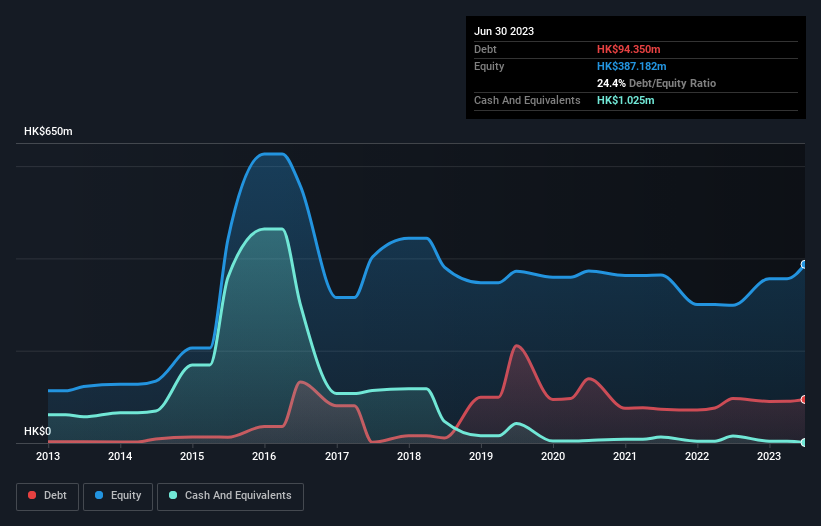- Hong Kong
- /
- Retail Distributors
- /
- SEHK:8179
Does Palinda Group Holdings (HKG:8179) Have A Healthy Balance Sheet?

The external fund manager backed by Berkshire Hathaway's Charlie Munger, Li Lu, makes no bones about it when he says 'The biggest investment risk is not the volatility of prices, but whether you will suffer a permanent loss of capital.' It's only natural to consider a company's balance sheet when you examine how risky it is, since debt is often involved when a business collapses. As with many other companies Palinda Group Holdings Limited (HKG:8179) makes use of debt. But should shareholders be worried about its use of debt?
What Risk Does Debt Bring?
Debt is a tool to help businesses grow, but if a business is incapable of paying off its lenders, then it exists at their mercy. In the worst case scenario, a company can go bankrupt if it cannot pay its creditors. However, a more usual (but still expensive) situation is where a company must dilute shareholders at a cheap share price simply to get debt under control. Having said that, the most common situation is where a company manages its debt reasonably well - and to its own advantage. The first step when considering a company's debt levels is to consider its cash and debt together.
Check out our latest analysis for Palinda Group Holdings
How Much Debt Does Palinda Group Holdings Carry?
The chart below, which you can click on for greater detail, shows that Palinda Group Holdings had HK$94.4m in debt in June 2023; about the same as the year before. And it doesn't have much cash, so its net debt is about the same.

How Strong Is Palinda Group Holdings' Balance Sheet?
Zooming in on the latest balance sheet data, we can see that Palinda Group Holdings had liabilities of HK$139.2m due within 12 months and no liabilities due beyond that. Offsetting this, it had HK$1.03m in cash and HK$177.4m in receivables that were due within 12 months. So it can boast HK$39.2m more liquid assets than total liabilities.
This excess liquidity is a great indication that Palinda Group Holdings' balance sheet is almost as strong as Fort Knox. On this view, lenders should feel as safe as the beloved of a black-belt karate master.
In order to size up a company's debt relative to its earnings, we calculate its net debt divided by its earnings before interest, tax, depreciation, and amortization (EBITDA) and its earnings before interest and tax (EBIT) divided by its interest expense (its interest cover). The advantage of this approach is that we take into account both the absolute quantum of debt (with net debt to EBITDA) and the actual interest expenses associated with that debt (with its interest cover ratio).
Palinda Group Holdings's net debt to EBITDA ratio of about 1.8 suggests only moderate use of debt. And its commanding EBIT of 10.0 times its interest expense, implies the debt load is as light as a peacock feather. Although Palinda Group Holdings made a loss at the EBIT level, last year, it was also good to see that it generated HK$52m in EBIT over the last twelve months. When analysing debt levels, the balance sheet is the obvious place to start. But it is Palinda Group Holdings's earnings that will influence how the balance sheet holds up in the future. So when considering debt, it's definitely worth looking at the earnings trend. Click here for an interactive snapshot.
Finally, a company can only pay off debt with cold hard cash, not accounting profits. So it's worth checking how much of the earnings before interest and tax (EBIT) is backed by free cash flow. Over the last year, Palinda Group Holdings saw substantial negative free cash flow, in total. While investors are no doubt expecting a reversal of that situation in due course, it clearly does mean its use of debt is more risky.
Our View
The good news is that Palinda Group Holdings's demonstrated ability to handle its total liabilities delights us like a fluffy puppy does a toddler. But we must concede we find its conversion of EBIT to free cash flow has the opposite effect. All these things considered, it appears that Palinda Group Holdings can comfortably handle its current debt levels. Of course, while this leverage can enhance returns on equity, it does bring more risk, so it's worth keeping an eye on this one. When analysing debt levels, the balance sheet is the obvious place to start. However, not all investment risk resides within the balance sheet - far from it. To that end, you should be aware of the 3 warning signs we've spotted with Palinda Group Holdings .
At the end of the day, it's often better to focus on companies that are free from net debt. You can access our special list of such companies (all with a track record of profit growth). It's free.
New: Manage All Your Stock Portfolios in One Place
We've created the ultimate portfolio companion for stock investors, and it's free.
• Connect an unlimited number of Portfolios and see your total in one currency
• Be alerted to new Warning Signs or Risks via email or mobile
• Track the Fair Value of your stocks
Have feedback on this article? Concerned about the content? Get in touch with us directly. Alternatively, email editorial-team (at) simplywallst.com.
This article by Simply Wall St is general in nature. We provide commentary based on historical data and analyst forecasts only using an unbiased methodology and our articles are not intended to be financial advice. It does not constitute a recommendation to buy or sell any stock, and does not take account of your objectives, or your financial situation. We aim to bring you long-term focused analysis driven by fundamental data. Note that our analysis may not factor in the latest price-sensitive company announcements or qualitative material. Simply Wall St has no position in any stocks mentioned.
About SEHK:8179
Palinda Group Holdings
An investment holding company, engages in the sale and distribution of wine products and ancillary wine-related products in Hong Kong, the British Virgin Islands, and Australia.
Slight with mediocre balance sheet.
Market Insights
Community Narratives



